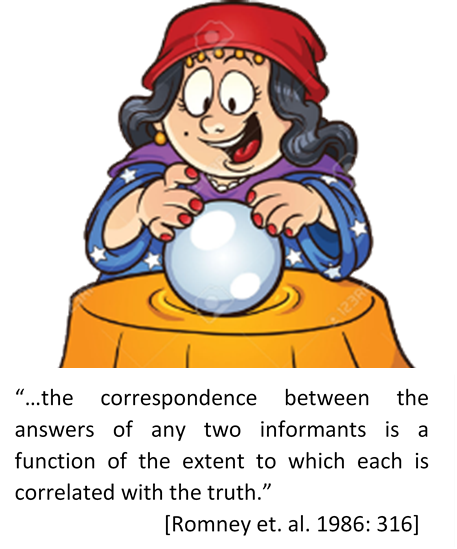This Anthropology Brief is a short explanation of Cultural Consensus Theory, which provides the basis for a strategy we developed and call Notab Leadership and Key Informant Network Strategy (NOLKINS). Cultural Consensus Theory yields formal mathematical models that allow researchers in underdeveloped areas to employ information gathering techniques far superior to surveys in terms of a) the quality of data, b) cost-effectiveness, and c) the capacity to establish information networks that can be tapped for information indefinitely and at low costs.
Haiti Anthropology Brief: Magic of Cultural Consensus Analysis

Cultural Consensus Theory allows researchers to ,
- a) determine competence of respondents by asking questions for which we do not know the answers
- b) detect correct answers without even knowing the questions
For example, an analyst using Cultural Consensus Theory techniques can ask a random group of say 50 people about the rules of soccer. Any particular individual’s responses will depend on how much that person knows about the game. Soccer fanatics will all tend to respond the same, with the correct answers. Those who somewhat know the game will respond correctly to some questions but will not know the answers to others and will therefore either not respond at all or will respond randomly, i.e they will guess. Those who know nothing at all about the rules of soccer will consistently not respond to questions or they will respond randomly, guessing at all the answers.
Thus, if we ask a large number of people the same questions about soccer, a pattern forms. When questions became exceptionally difficult, only those respondents most knowledgeable about the game of soccer will respond correctly. And these people will typically have the same answer, i.e. the correct one. Responses from other informants tend to be blank or randomly distributed. There emerges what Romney et. al. term a “concordance code” of socially shared information. In this case the information is about the rules of soccer.
Cracking that “concordance code” can be done by systematically evaluating the answer given by each respondent vis a vis the other respondents. It is this ‘analysis of consensus’ among respondents that allows us to determine with mathematical precision the competence of each informant regarding the rules of soccer. And it allows us to determine with mathematical precision the correct answers to questions even when, as counter-intuitive as this might sound, we don’t even know what the questions are, i.e. we depend on the pattern of responses. This is true whether we are talking about true/false questions, multiple choice, or fill in the blank.
These same formulas have long been used in high schools and Universities to inform professors of bad exam questions. For example, when a particular question and/or answer is simply wrong or perhaps the information was not even taught in the course, many students do not know the answer and hence guess. Thus, the pattern of responses from the students on these bad questions goes random. Even the brightest and most competent students—as indicated by the concordance code—tend to get those answers wrong (because they have not been exposed to that knowledge).
What these patterns mean for Humanitarian Aid targeting is that we can build on the free-listing model and use the algorithms that Cultural Consensus Analysts provide to determine experts or to select most appreciated notab. Once we have these lists, we can ask the notab other questions and come up with new “concordance codes” that tell us which notab are most competent and honest. In effect, we can grade notab like students, determining who are the best and brightest.
For a more detailed review of Cultural Consensus Theory see,
Borgatti, S. P. 1992. ANTHROPAC 4.0 reference manual. Natick, MA: Analytic Technologies.
———. 2002. A statistical method for comparing aggregate data across a priori groups. Field Methods 14 (1): 88–107.
Romney, A. Kimball, Susan C. Weller, and William H. Batchelder. 1986. Culture as Consensus: A Theory of Culture and Informant Accuracy. In American Anthropologist, New Series, Vol. 88, No. 2 (Jun.), pp. 313-338.
Weller, S. C., and A. K. Romney. 1988. Systematic data collection. Newbury Park, CA: Sage.







